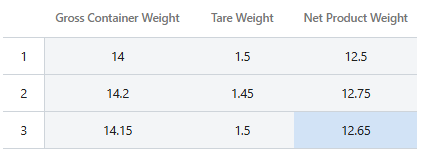Often, calculated measures are established for convenience. For example, suppose you have the process measures of gross container weight and tare weight. You can create an equation to subtract the tare weight from the gross container weight to calculate the net product weight.
Add a calculated measure to a process
Calculated measures are associated with processes. To add a calculated measure to a process, open the process template.
- In the Measures section of the template, select Add Calculated Measure.
- Enter a name and an optional description for the new measure.
- Enter a valid equation. Equation variables must be previously set up
process, output, or other calculated measures. Variable names must use the
following format, with an underscore at the beginning and end of the name,
_VariableName1_.Note
Select the Show Variables link to display the available measures.
- Select OK and save your changes to the process template.
For more information on process and output measures, go to Continuous measures.
Valid equations
Real-Time SPC supports basic mathematical functions. The equation syntax requires parentheses for functions, exponents, multiplication, and following the order of operations (PEMDAS).
- Calculate net weight
- Subtract tare weight from gross weight.
subtract(_Gross Container Weight_,_Tare Weight_)_Gross Container Weight_ - _Tare Weight__Gross Container Weight_ - 1.5
- Calculate area
- Multiply length and width.
multiply(_Length_,_Width_)_Length_ * _Width_
- Calculate the mean of several measures
mean(_Measure1_,_Measure2_,_Measure3_,_Measure4_)- Calculate the standard deviation of several measures
std(_Measure1_,_Measure2_,_Measure3_,_Measure4_)
Note
Only valid measures associated with the same process as the calculated measure are available for use as equation variables.
Deleted equation variables
If the equation for a calculated measure contains a deleted measure, the equation
is no longer valid. The equation remains; however, the deleted measure is
represented by a system id value. For example the following valid equation,
_Gross Container Weight_ - _Tare Weight_,
becomes invalid when _Tare Weight_ is deleted
from the process.
The invalid equation contains a system id value instead of a valid measure name
(_Gross Container Weight_ - _12_).
Real-Time SPC retains all previous calculations. Subsequent data collections will use a null value until the equation is valid again.
Sampling plan details

Note
All measures used in a calculated measure must be in the same sampling plan as the calculated measure. For more information, go to Overview of data collection methods for sampling plans.

In this example, the calculated measure, Net Product Weight, has a subgroup size of n=3. Because the subgroup size for Tare Weight is n=1, the calculated measure only records one observation for the data collection. The Xbar-R chart for the calculated measure cannot display the data because the Xbar-R chart requires at least 2 observations to calculate the range of the data.
Edit observations
- Plotted points of the control chart
- Tests for special causes
- Summary and performance statistics
- If the original calculated data point was flagged and had assignable causes and/or corrective actions, these will remain if the point still exceeds the limits. If the point no longer exceeds the limits, the flag is removed; however, the assignable causes and correctives remain.
Note
You cannot edit calculated measures directly. You can only edit them by editing one of the measures within the equation.
